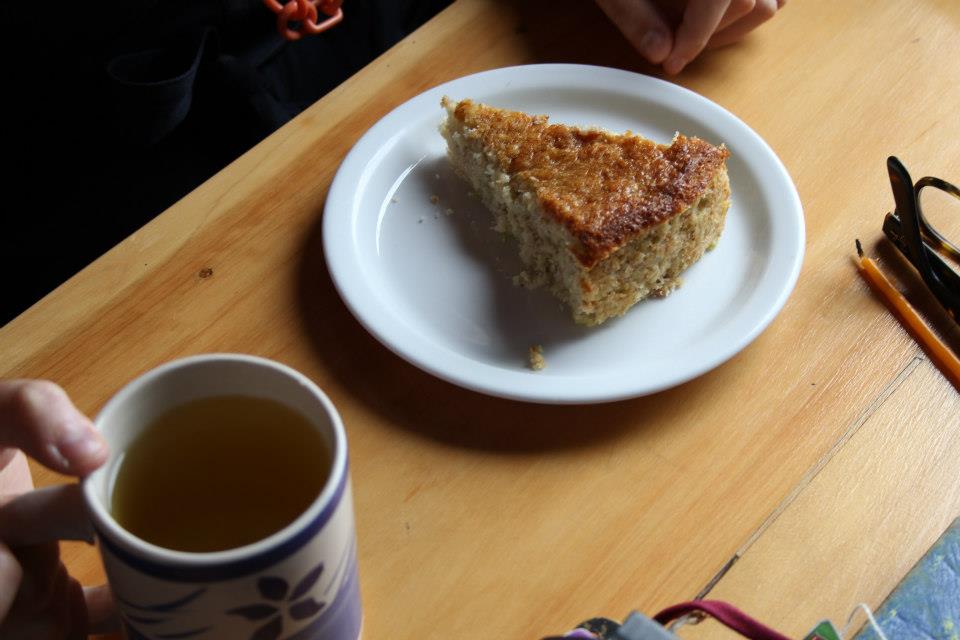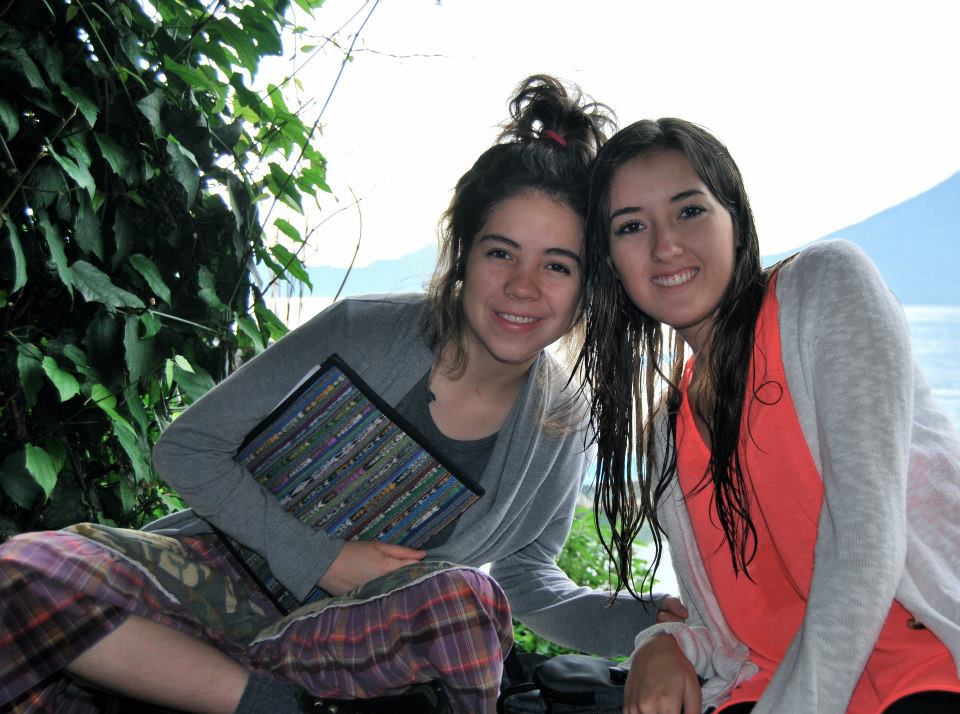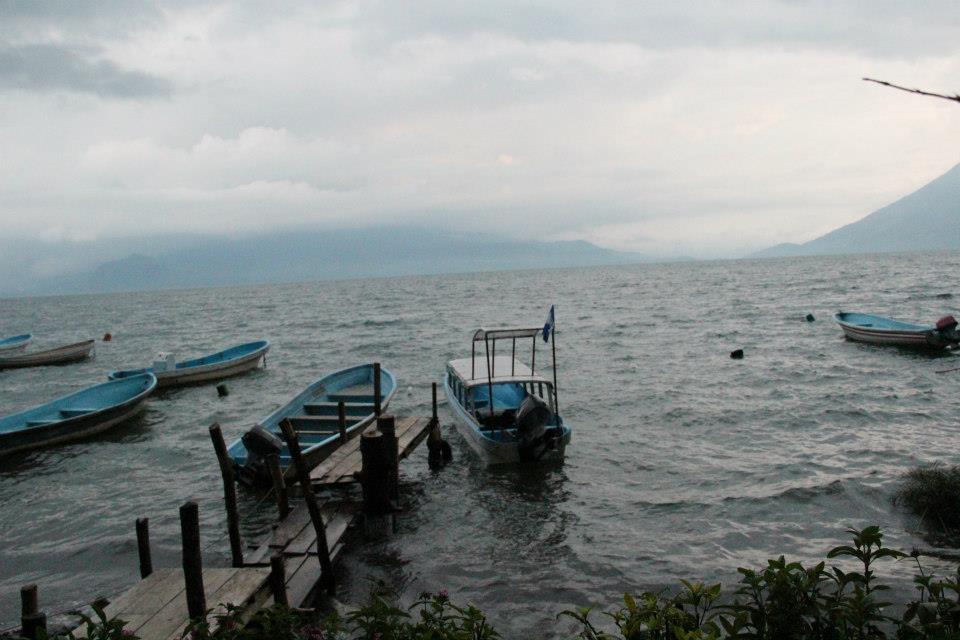Katarina guided us the MPC'ers through the Popol Vuh Museum (she is an official tour guide there). The result was terrible. Few people payed attention to her, and even though I thought I was going 'again', I noticed Kata was saying really interesting things. New things I learned about our past civilizations are that,- One of the codes we have in the Popol Vuh was found by a German archaeologist in Guatemala and he took it back to Germany. The World War II happened, and his house was destroyed (he died.). On the ashes of his house, the code was found.
- The Jaguar is the god of death, and also of the Sun. The Sun comes out and back all the mornings, it dies and it comes alive again.
 Photo Credit : Javier Parellada Part IV
It's Ana Isa's Birthday! And also our last day at the Iguana.
We signed in for the morning meeting, and Javier Parellada explained the activity: to say something funny, something we learned about ourselves in the trip and also, what we learned of the person to our left. There were so many funny anecdotes. We also received feedback from others.
The morning evolved quickly, we had to finish our outlines, and also we had to make an essay about those. You can download that here:
 | mpc_-_handbook_-_mabe.docx | | File Size: | 5 kb | | File Type: | docx |
Download File
Then, we had a dialogue on the first piece of poem that Emerson wrote before his essay "Self Reliance":
"Man is his own star; and the soul that can
Render an honest and a perfect man,
Commands all light, all influence, all fate;
Nothing to him falls early or too late.
Our acts our angels are, or good or ill,
Our fatal shadows that walk by us still."
It is a powerful paragraph, if meditated. Like a guiding star (in Lucía's words), man is his own guiding light. Our actions and our consequences are present even in for good or for bad.
We are the ones who define. And that is how our trip concluded.
 Photo Credit : Isa Moino Part III
At the beginning of the trip we were given a Handbook which contained several readings. In those, there were a set of essays named The Role of the Liberal Arts in College Education. Each of those essays were extremely connected. They were a bunch of ideas, if we bring up the argument that Wayne C. Booth (an author of one of those essays) mentions when he talks about ideas. " An idea is always connected to other ideas that lead to it, follow from it, or somehow support it."These are the names of the essays, and there's a little insight to all of them:- Introduction to The Role of the Liberal Arts in a College Education: Some people considerate the studying of the liberal arts as something unnecessary. Understanding the history, nature and joining the "academic conversation" and having that knowledge one can understand the value of this study.
- The Earthly Use of a Liberal Education (by A. Bartlett Giamatti) : "A liberal education is defined by the attitude of the mind toward the knowledge the mind explores and creates. Such education occurs when you pursue knowledge because you are motivated to experience and absorb what comes of thinking."
The education for lifelong learners is a liberal education. That love towards the independent search for ideas. One can make a living by searching for ideas, but by one's own work, by sparkling the own mind.
- What is an Idea? (by Wayne C. Booth): We tend to mistake ideas with opinions, or other mental products. The characteristics of the ideas are that they're connected to one another, they reproduce and this reproduction is capable of being directed in different ways. "A liberal education is an education in ideas -- not merely memorizing them, but learning to move among them, balancing one against the other, negotiating relationships, accommodating new arguments, and returning for a closer look."
- The Liberal Studies (by Carey W. Brush): Brush takes us to a historical journey of the evolution of the liberal arts and why are certain subjects studied. There's a common factor throughout these studies, which embark since the ancient Greece. "While the content of the liberal studies has expanded, the purpose of a liberal education remains relatively unchanged -- to prepare individuals to live the good life and to be responsible citizens." By making connections, the liberal education is possible in whichever field. The antithesis of liberal education is the "fatal disconnection of subjects". Everything is connected.
- The Purposes of Liberal Education (by Henry Rosovsky): Rosovsky emphasizes in the qualities and abilities of a well-educated person: writing skills, critical thinking, awareness of the different cultures, the further experience on moral and ethics and the achievement of depth in some field of knowledge. But it's important to recall that there should be a general knowledge, so you can make connections! :)
So this was an important part of the day, after that we went to San Juan la Laguna, which is a place well known for its foundation from the agreement of the citizens to discuss about the well being of their community. If one compares what happens in this town compared to others, it is visible how peaceful and organized this one is. And it was not a matter of an authority controlling the development of the town, it was the agreement of the individuals through conversation to make their environment better. Reading Benjamin Franklin's autobiography, I can't help to think in the Junto, which was also a group who discussed the issues of the town and brought them into discussion. There are great textiles in San Juan la Laguna, and they are dyed with natural ink. Really cool! Besides, the manufacturers sell their stuff via Internet! Check this out: http://www.sanjuanlalaguna.orgI mean, FOR REAL! The Guatemalan government keeps most people stuck with their communities without letting them to actually develop by their own will. San Juan la Laguna is what happens when people are let FREE man! FREE! Continuing with this amazing day, we went back to Iguana Perdida, and we met COLE-BLODGETT. Allow me to post a picture of this great person:
Part II
I remember waking up at the middle of the night and hitting my head with the roof. After that, I woke up and walked to the little town up the hill to the town. It was really little. Not much to see, and the school was like a dying building.
I returned and had the morning meeting and breakfast. I was given the question at the morning meeting so I can start working in the Handbook:
"How does an MPC student receive a guest to the MPC?"
I loved my question. I got through important factors, such as environment and behavior. After working in my question, I put it in an outline structure. You can download that here:
 | outline_handbook_2012.docx | | File Size: | 4 kb | | File Type: | docx |
Download File
I worked through that outline for a substantial amount of time. We discussed it with our group, and after that we got to work to our "Group Work Rubric" which you can see by clicking here. Working in group is a huge challenge for me, specially if it is conformed with people with different ends than mine. It's interesting to build a rubric, because it actually considers those intrinsic characteristics of the members. Maybe our rubric won't work as well with other groups. Even comparing, they would have common characteristics, but still there would be different. We tried to make some astronomy that night. The stars were not visible, but we talked of Ptolemy with Bert. How people stop doubting and founding their ideas in the very logical proposition that Ptolemy made. And how we, lazy nonagers (I had to say that, sorry), just got comfortable with Copernicus as truth because it's what is accepted. Bert mentioned how in St. John's people get to doubt of the heliocentric theory! Because they study the system of Ptolemy. After all, this is all a matter of language.
Part I
I had to wake up at 4 AM. I was running, I had to make my bag.
After that, I arrived late to the MPC headquarters.
With a headache on me, we arrived to Santa Cruz la Laguna, to the Iguana Perdida. Such an amazing place. It was founded in 1995, when the place was nearly deserted. The community is still little, compared to San Pedro or Panajachel.
Definitely, the environment is one important part of the learning process. The first thing we got to do was reading Benjamin Franklin's Autobiography. We got together with Ines to read him aloud. His language is absolutely artistic. I really enjoyed reading him besides, with Ines we got to discuss parts we didn't understand. He starts with a call to his son, but he doesn't mention him again until further (I DISCOVERED A PART!)
After reading some of his work, I must say Franklin is a autodidact, hardworking man. He had a desire to go to the sea, but still he had the restriction coming from his father. He also was a vegetarian (YES!) for a while (lamentably). He also was a reader and enjoyed: De Foe's "Essay on Projects" (De Foe is the writer of Robinson Crusoe). He got into Socratic Dialogue, and he was a great questioner. He loved the Spectator and took it as a standard from which he could work on.
But returning to Iguana Perdida, we had a dialogue and a little quiz of this reading. Sincerely, I learn so much from the dialogues and what I talked with Ines, so I enjoyed reading with her the most.
We had issues with the commitment we made for buying the food. For that, we had a large discussion in which I got really uncomfortable. I wish we sat to think more on solutions instead of starting arguing so much. I just like to be peaceful. Serenity.
We sang all along with Alejo, since there were two guitars available. It was cool, I need instruments to feel somehow peaceful.
|




 RSS Feed
RSS Feed